Investigations
Fact-Check: Trump’s False Claims About South Africa Debunked During White House Meeting
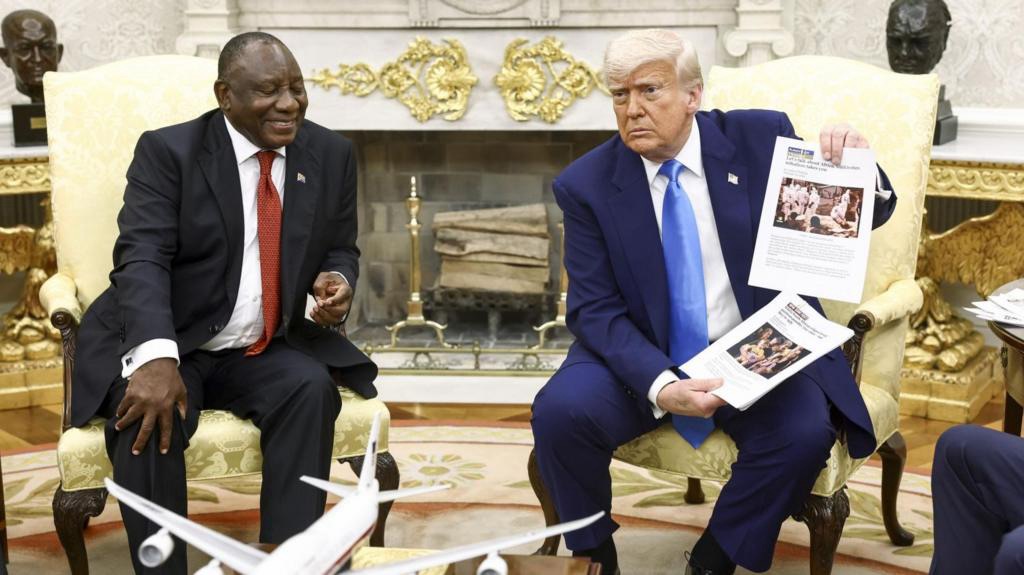
A comprehensive analysis reveals multiple inaccuracies in statements made during high-stakes diplomatic talks
In an extraordinary White House confrontation on May 21, 2025, U.S. President Donald Trump ambushed South African President Cyril Ramaphosa with what can only be described as a carefully orchestrated presentation of misinformation. Armed with press clippings from obscure websites, debunked video footage, and false evidence, Trump made repeated unsubstantiated claims while interrupting Ramaphosa’s attempts to provide factual corrections. Our comprehensive fact-checking analysis reveals a disturbing pattern of deliberate misrepresentation designed to support a false narrative.
The Meeting Context
What was meant to be a diplomatic reset after months of strained U.S.-South Africa relations instead became what observers described as “a painful job review carried out by a boss on a loud hailer.” The encounter came just weeks after 49 white South African farmers emigrated to the United States as refugees, providing Trump with ammunition for his unfounded claims.
The meeting was broadcast globally, creating what the BBC described as “brutal, high-stakes diplomacy, peppered with insults, and played out to millions across the world in real time.” Ramaphosa, seeking crucial trade agreements and economic cooperation, instead found himself defending his country against a barrage of misinformation.
Claim 1: “White Genocide” in South Africa
Trump’s Claim: The U.S. President held up a photograph claiming it showed “white farmers that are being buried,” presenting it as evidence of mass killings targeting white South Africans.
The Facts: The image was falsely attributed. The photograph actually showed humanitarian workers handling body bags in Goma, Democratic Republic of Congo—not South Africa. This represents a clear case of misleading visual evidence.
Reality Check: South Africa does face a severe crime crisis, with approximately 72 murders daily in a nation of 60 million people. However, official 2024 police statistics show that of 26,232 total murders, only 44 were connected to farming communities, with just eight victims being farmers themselves. The overwhelming majority of South Africa’s murder victims are Black individuals.
Legal Verdict: Earlier this year, the Western Cape High Court explicitly ruled that claims of “white genocide” were “clearly imagined and not real.”
Claim 2: “Kill the Boer” Song as Incitement to Violence
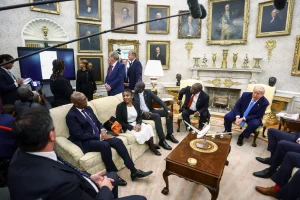
US President Donald Trump, right, and Cyril Ramaphosa, South Africa’s president, second right, as a video plays during a meeting in the Oval Office of the White House in Washington, DC, US, on Wednesday, May 21, 2025.
Bloomberg/Getty images
Trump’s Claim: The President questioned why Economic Freedom Fighters leader Julius Malema hadn’t been arrested for his “Kill the Boer” chant, implying it was a direct call for violence against white farmers.
The Facts: The song “Dubul’ ibhunu” (Kill the Boer) is a historical liberation struggle song from the 1980s apartheid resistance movement. Three separate court cases have ruled against designating it as hate speech, with judges determining it represents historical resistance rather than literal incitement to violence.
Context: The Economic Freedom Fighters clarified that the song “expresses the desire to destroy the system of white minority control over the resources of South Africa” and represents “African heritage.”
Claim 3: Highway Crosses as Mass Graves
Trump’s Claim: Video footage showed white crosses along a highway, which Trump described as “burial sites right here. Burial sites. Over 1,000. Of white farmers… They’re all white farmers, the family of white farmers.”
The Facts: This represents perhaps the most egregious mischaracterization. The footage showed a September 2020 farm attack protest near Newcastle, KwaZulu-Natal, organized by local farming communities following the murder of Glen and Vida Rafferty the previous month.
Reality Check: According to the Institute of Race Relations, approximately 500 symbolic crosses (not “over 1,000” as Trump claimed) were temporarily erected during this multi-racial protest. No bodies were buried at the site—it was purely symbolic. The demonstration occurred on a Saturday, not Sunday as Trump claimed, and involved people from various racial backgrounds, contradicting Trump’s assertion that it was exclusively about white farmers.
The case that sparked the protest was quickly resolved by police, and the memorial was temporary, designed to draw attention to farm-related crime generally, not specifically targeting white farmers.
Claim 4: Fabricated Press Clippings and Misleading Sources
Trump’s Claims: The President presented a pile of press clippings with headlines like “Brutal farm attack in South Africa: Elderly man beaten, hacked with machete, and left for dead,” while saying “Death of people, death, death, horrible death.”
The Facts: Investigative analysis reveals these sources to be deeply problematic:
- The headline format doesn’t match any reputable news outlet, appearing to be sourced from social media posts rather than original reporting
- One article Trump described as showing “horrible death” actually reported on an attack where the victims survived
- Several clippings came from partisan American blogs, including American Thinker, which provides little evidence for its inflammatory claims
- One American Thinker article Trump claimed was about “white South African farmers being burned” actually referenced women in the Democratic Republic of Congo as victims
- Many articles originated from unverifiable sources or were based entirely on social media posts
This pattern suggests a deliberate curation of misleading and inflammatory content designed to support a predetermined narrative rather than present factual information.
Statistical Reality
Current Crime Statistics: South African police data for 2024 confirms the reality differs dramatically from Trump’s claims:
- Total murders: 26,232 nationwide
- Farm-related murders: 44 cases total
- Farmers specifically killed: 8 individuals
- Daily murder average: 72 deaths (in a nation of 60 million)
- Primary victims: Overwhelmingly Black South Africans
Farm Murder Trends: Official data shows yearly farm murder totals have ranged between 49 and 63 since 2020, with the majority attributed to robbery motives rather than racial targeting. Academic researchers and independent monitoring groups have found no evidence supporting claims of systematic execution or genocide.
Land Ownership Reality: Approximately three-quarters of privately-owned farmland remains in white hands (representing less than 8% of the population), while Black South Africans (80% of the population) own just 4% of farmland. Recent legislation allows state land expropriation “in the public interest” without compensation only in specific, rare circumstances, and has not yet been implemented.
My take
The May 21 White House meeting represents a troubling example of how carefully curated misinformation can be weaponized in international diplomacy. Trump’s presentation—featuring doctored evidence, misleading photographs, fabricated press clippings, and inflammatory rhetoric—appears designed not to seek truth but to pressure South Africa through false narratives.
The incident highlights several concerning trends:
- The use of selectively edited video and social media posts as diplomatic “evidence”
- Misrepresentation of temporary protest memorials as permanent burial grounds
- Conflation of general violent crime with targeted persecution
- Reliance on partisan blogs and unverifiable sources over official statistics
International Implications: While the confrontation failed to produce the diplomatic breakthrough either side might have wanted, it demonstrated the resilience of fact-based governance in the face of coordinated misinformation. The support Ramaphosa received from his diverse coalition partners effectively countered Trump’s narrative with lived South African reality.
Verification Standards: This case shows the critical importance of rigorous fact-checking in international relations. When world leaders present “evidence,” the global community must demand the same verification standards we expect from credible journalism: multiple sources, official statistics, and transparent methodology.
The diplomatic meeting may have ended without resolution, but it provided a stark reminder that in the information age, truth remains the most valuable diplomatic currency—and the most vulnerable to manipulation.
Kenya Insights allows guest blogging, if you want to be published on Kenya’s most authoritative and accurate blog, have an expose, news TIPS, story angles, human interest stories, drop us an email on [email protected] or via Telegram
-

 News2 days ago
News2 days agoKenyan Driver Hospitalized After Dubai Assault for Rejecting Gay Advances, Passport Seized as Authorities Remain Silent
-
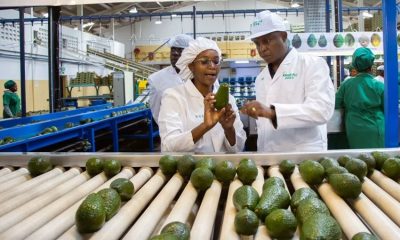
 Business1 week ago
Business1 week agoKakuzi Investors Face Massive Loss as Land Commission Drops Bombshell Order to Surrender Quarter of Productive Estate
-

 Investigations1 week ago
Investigations1 week agoINSIDER LEAK REVEALS ROT AT KWS TOP EXECUTIVES
-

 Business2 days ago
Business2 days agoConstruction Of Stalled Yaya Center Block Resumes After More Than 3 Decades and The Concrete Story Behind It
-
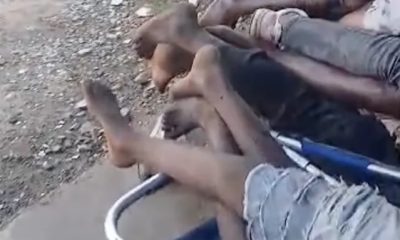
 Investigations6 days ago
Investigations6 days agoCNN Reveals Massive Killings, Secret Graves In Tanzania and Coverup By the Govt
-

 Business1 week ago
Business1 week agoBANKS BETRAYAL: How Equity Bank Allegedly Helped Thieves Loot Sh10 Million From Family’s Savings in Lightning Fast Court Scam
-
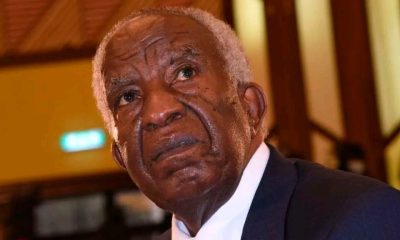
 News1 week ago
News1 week agoEXPOSED: How Tycoon Munga, State Officials, Chinese Firm Stalled A Sh3.9 Trillion Coal Treasure In Kitui
-
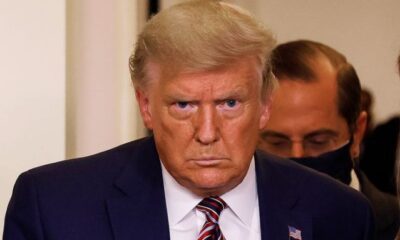
 Investigations3 days ago
Investigations3 days agoHow Somali Money From Minnesota Fraud Ended In Funding Nairobi Real Estate Boom, Al Shabaab Attracting Trump’s Wrath
















